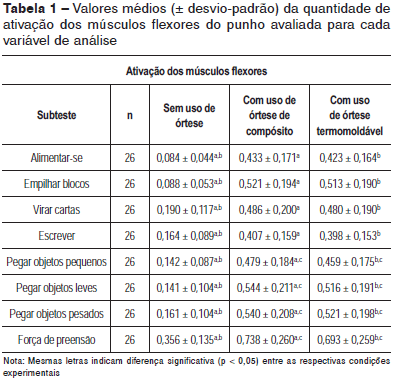OBJECTIVE: to investigate the effect of wrist immobilization orthoses, made from different materials, on activation of the flexor and extensor musculature of the forearm while performing specific tasks. METHODS: Twenty-six adults, with an average age of 26.2 years, performed the Jebsen-Taylor functional hand test and the Grip Strength test (James® dynamometer) under three conditions: free hand, wearing a composite orthosis, and wearing a thermoplastic orthosis. The tests were carried out using the dominant hand only. During the tests, surface electrodes were placed on the flexor and extensor muscles of the forearm to record the electrical muscle activity. The results obtained in the three conditions were compared, and the results analyzed using the statistical Wilcoxon Test. RESULTS: Significant differences were found in muscle activation when comparing the free hand with the use of any of the orthoses. In the comparison of data for the two different orthoses, no significant differences were found. A decrease in activity of the extensor muscles of the forearm was observed during all the tasks, as well as an increase in activation of the flexor muscles with the use of the orthoses. CONCLUSION: These results are important for the prescription of an orthosis during the rehabilitation process of a wide range of pathologies, such as tendinitis of the flexors and extensors of the first and fingers, as well as for forecasting the time of use of these devices.
Orthopedic devices; Wrist; Electromyography



